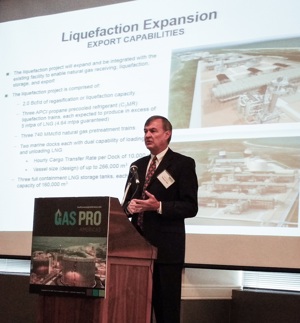GasPro '16: Freeport LNG exec touts viability of US LNG exports

By Adrienne Blume, Editor
HOUSTON—Day one of Gulf Publishing Company's GasPro Americas conference opened on September 13 with a keynote speech from Mark Mallett, senior vice president of operations and projects for Freeport LNG.
Mallett spoke about the Freeport LNG project, existing LNG production and trade in the Americas, and the outlook for the global LNG marketplace.
Freeport LNG export project. Freeport LNG was founded in 2002 to build the first regasification terminal in the US in 20 years, located on Quintana Island near Freeport, Texas. The project began commercial regasification operations in June 2008. Shortly thereafter, however, the company made the executive decision to develop a liquefaction and export project in response to the US shale gas boom.
Mallett explained how Freeport LNG leveraged its existing assets to enable the addition of a $2-B LNG terminal capable of liquefying more than 2 Bcfd of gas. Work on the liquefaction and export terminal commenced in 2014.
The terminal's first three trains have been approved for construction, and an expansion will see the addition of a fourth train. Freeport LNG expects to file a formal application for the fourth train with the US Federal Energy Regulatory Commission in 4Q 2016.
Train 1 commercial operations are anticipated to start in September 2018, with first gas being introduced to the train in 2Q 2018. Train 2 is slated for tentative startup in February 2019, Train 3 is scheduled to come online in August 2019 and Train 4 could start up as early as 2021.
The SVP noted that Texas is the third-largest natural gas producing area in the world. The Freeport LNG export terminal's location in Texas, near the Eagle Ford shale, gives it excellent proximity to gas feedstock and to pipeline infrastructure.
Freeport LNG's customers include several Japanese companies—Osaka Gas, JERA and Toshiba—as well as the UK's BP and Korea's SK E&S. EPC contractors for the liquefaction and export project include CB&I, Zachry Construction and Chiyoda Corp.
Global LNG market perspective. LNG trade is roughly 50 years old, Mallett explained. Approximately 32 Bcfd of LNG is traded among 19 exporting countries and 30 importing countries. The vessel fleet dedicated to LNG trade is presently at 400—a considerable number.
"However, current demand concerns persist from East Asia to the Atlantic, driven by low crude oil prices, high storage inventories, and increased fuel substitution," Mallett explained. He referred to the nuclear shutdowns in Japan in the wake of the Fukushima disaster in March 2011, which initially spurred massive LNG imports. However, Japan is in the midst of restarting its nuclear plants and Korea is starting up new coal-fired plants, putting a dent in the two countries' LNG demand.
On the supply side, new liquefaction capacity from Australia and the US will contribute to an expected global LNG capacity addition of 21 Bcfd over the next several years. These capacity additions will result in a worsening supply glut of the fuel. Mallett noted that 620 Bcmy of announced liquefaction projects are chasing 140 Bcmy of incremental LNG demand, which means that many planned projects will not be built.
If necessary, Mallett said, Freeport LNG can scale back its liquefaction operations if the supply overhang becomes too great—similar to how it scaled back its regasification operations in 2008 at the onset of the US shale boom. The company can do this by cutting back its supply contracts, the SVP explained.
However, Mallett believes that continued growth in global demand for LNG will support well-conceived and well-executed projects with access to affordable gas feedstock and developed distribution infrastructure, such as those planned for the US. On the demand side, Asian gas consumption will continue to expand over the long term, supporting US LNG and other gas export projects around the world.
"We believe that growth is going to continue, driven by Asian demand, particularly China; although, it will be somewhat slower than initially forecast," Mallett said. "We also believe US exports will continue to change the game and provide diversity of supply to Asian importers. Countries like Japan and China are looking at long-term supply, and they will be able to buy LNG on US gas prices."
In light of this outlook, "We believe Freeport LNG is well positioned to take advantage of growth in global LNG demand," Mallett concluded.






Comments